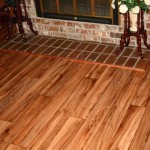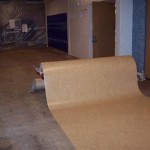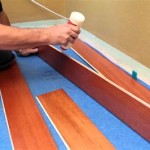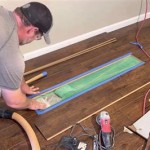How Wide Is Tongue And Groove Flooring?
Tongue and groove flooring, a time-tested method of joining planks, is characterized by its interlocking system. One edge of each board features a 'tongue' – a projecting tenon, while the opposing edge has a corresponding 'groove' – a recess that accepts the tongue. This design creates a strong, visually appealing, and often airtight surface when the boards are seamlessly fitted together. Understanding the various widths available in tongue and groove flooring is crucial for achieving the desired aesthetic and structural integrity in any flooring project.
The width of tongue and groove flooring is a significant factor influencing both the appearance and the installation process. Wider planks generally create a more modern and spacious feel, while narrower planks can evoke a more traditional and detailed look. Furthermore, the width impacts the stability and dimensional movement of the flooring, particularly in response to changes in humidity. This article will explore the variety of widths available for tongue and groove flooring, discussing the advantages and disadvantages of each, and considering relevant factors such as material, style, and installation.
Standard Widths in Tongue and Groove Flooring
While considerable variation exists, several widths can be considered standard for tongue and groove flooring. These commonly encountered sizes offer a balance between aesthetic appeal, ease of installation, and material availability. Understanding these standard widths provides a foundational understanding for selecting the appropriate flooring for a specific project.
Narrow plank flooring, often ranging from 2 1/4 inches to 3 1/4 inches in width, is a classic choice. This width is particularly well-suited for smaller rooms or spaces where a more detailed and intricate floor pattern is desired. The narrower planks tend to emphasize the length of a room and can create a visually busy, yet elegant appearance. Historically, narrower planks have been prevalent, reflecting traditional milling practices and the availability of smaller timber resources.
Medium width planks, typically measuring between 3 1/2 inches to 5 inches, represent a versatile option that bridges the gap between narrow and wide planks. This width offers a balanced aesthetic, suitable for a variety of room sizes and design styles. Medium width planks are often considered easier to install than narrower planks, as they cover more surface area per board, reducing the number of individual pieces requiring placement and fastening. They also tend to exhibit less pronounced cupping or crowning compared to wider planks, as the dimensional changes are distributed across a smaller surface.
Wide plank flooring, generally defined as planks wider than 5 inches, has gained significant popularity in recent years. These planks can range from 5 inches to upwards of 12 inches or even wider. Wide plank flooring creates a more expansive and contemporary aesthetic, emphasizing the natural grain patterns and character of the wood. Wide planks are well-suited for larger rooms, where they can create a sense of spaciousness and minimize the number of visible seams. However, wide planks require careful consideration of subfloor preparation and acclimation to ensure stability and minimize the risk of warping or cupping.
Impact of Material on Width Selection
The type of wood used for tongue and groove flooring significantly influences the optimal width. Different wood species possess varying degrees of dimensional stability, hardness, and susceptibility to moisture. These characteristics must be considered when selecting the width of the flooring to ensure long-term performance and minimize potential issues such as warping, cupping, or gapping.
Hardwoods, such as oak, maple, and hickory, are generally more dimensionally stable than softwoods like pine or fir. This means hardwoods are less prone to expansion and contraction in response to changes in humidity. As a result, hardwoods can often be used in wider plank formats with a lower risk of problems. However, even within the hardwood category, variations exist. Certain species, like white oak, are naturally more water-resistant than others, making them more suitable for areas with higher moisture levels, even in wider plank formats.
Softwoods, while often more affordable, are generally less dimensionally stable and more susceptible to moisture damage. Therefore, when using softwood for tongue and groove flooring, it is generally advisable to opt for narrower planks. Narrower planks are less prone to cupping or warping because any dimensional changes are distributed across a smaller width. Proper sealing and finishing are also crucial for softwood flooring to protect it from moisture absorption.
Engineered wood flooring offers an alternative to solid wood, often providing greater dimensional stability. Engineered wood consists of multiple layers of wood veneer bonded together, typically with a hardwood wear layer on top. This construction method reduces the wood's tendency to expand and contract, allowing for wider planks to be used with less risk of problems. Engineered wood is also more resistant to moisture than solid wood, making it a suitable option for basements or other areas with high humidity.
Considerations for Installation and Maintenance Based on Width
The width of tongue and groove flooring impacts the installation process, the required skill level, and the long-term maintenance needs. Understanding these considerations is crucial for a successful and durable flooring installation. Proper preparation, installation techniques, and ongoing maintenance practices are equally important to ensure the longevity and aesthetic appeal of the flooring.
Narrower planks are generally easier to install, particularly for DIY enthusiasts. The smaller size and weight of individual planks make them easier to handle and maneuver. The installation process involves aligning the tongue and groove, tapping the planks together to create a tight seam, and securing them to the subfloor with nails or adhesive. While narrower planks require more pieces to cover a given area, the relative ease of handling can offset this disadvantage.
Wider planks, while offering a more expansive aesthetic, require greater precision during installation. The weight and size of wider planks can make them more challenging to handle, and any misalignment is more readily apparent. It is crucial to ensure the subfloor is perfectly level and flat before installing wide plank flooring to prevent unevenness or rocking. Furthermore, wider planks may require additional fasteners to ensure they are securely attached to the subfloor and prevent warping or cupping.
Maintenance practices also vary depending on the width of the flooring. Narrower planks, with their more numerous seams, may require more frequent cleaning to prevent dirt and debris from accumulating in the grooves. Wide plank flooring, with its fewer seams, is generally easier to clean. However, both narrow and wide plank flooring should be regularly swept or vacuumed to remove surface dirt and grit that can scratch the finish. Periodic mopping with a pH-neutral cleaner is also recommended to maintain the flooring's appearance. It's also important to consider the finish applied and the type of wear it will endure. A durable finish helps protect all widths of flooring from scratches and moisture, but it's especially important for wider planks which can be more susceptible to movement due to environmental factors.
Furthermore, acclimation is extremely important for all widths, but especially vital for wider planks. Acclimation involves allowing the flooring to adjust to the ambient temperature and humidity levels of the installation environment before installation. This process helps to minimize expansion and contraction after installation, reducing the risk of warping, cupping, or gapping. Acclimation typically involves storing the flooring in the room where it will be installed for several days or even weeks, depending on the wood species and the local climate. Checking the moisture content of both the subfloor and the flooring prior to installation is also recommended to ensure they are within acceptable ranges.
Ultimately, the optimal width for tongue and groove flooring depends on a variety of factors, including the desired aesthetic, the size of the room, the type of wood, and the installer's skill level. Careful consideration of these factors will help to ensure a successful and long-lasting flooring installation.

1 X 6 Tigerwood T G Decking

Malibu Wide Plank Torrey French Oak 9 16 In T X 7 5 W Tongue Groove Wire Brushed Engineered Hardwood Flooring 1259 3 Sq Ft Plt Hdmttg672efp The Home Depot

Premium Wide Pine Plank Flooring

Tongue And Groove A Comprehensive Guide

What You Need To Know About Tongue And Groove Flooring Installation Reallyfloors America S Est Hardwood

Malibu Wide Plank Stinson French Oak 1 2 In T X 7 5 W Water Resistant Wire Brushed Engineered Hardwood Flooring 23 3 Sq Ft Case Hdmptg940ef

25mm X 150mm 1m Redwood Planed Tongue And Groove Flooring 5th Finished Size 20 5mm 144mm Travis Perkins

Wide Plank Flooring Makes A Beautiful Statement

Malibu Wide Plank Half Moon French Oak 1 2 In T X 5 7 W Tongue Groove Distressed Engineered Hardwood Flooring 24 9 Sq Ft Case Hdmstg292ef The Home Depot

1x6 Southern Yellow Pine Tongue Groove Flooring C Better Grade
Related Posts








